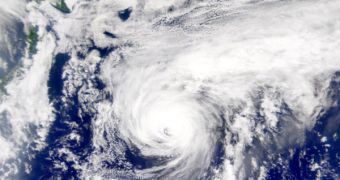Scientists in Taiwan discovered that the massive floods huge storms generate are nature's way of getting rid of free carbon in plants and soils throughout several regions of the globe. Rainfall also plays a part in the process, but typhoons and hurricanes carry over 5000 tones of carbon to the ocean floors every year in Eastern Asia alone.
The researchers conducting these measurements had to undergo severe conditions to gather these results, subjecting themselves to powerful winds and storms. In the midst of 2004's Mindulle typhoon, the scientists hanged on to firm patches of land and sunk bottles in swollen rivers, to collects samples of the sediments they carried. They concluded that thousands of tones of carbon were embedded into ocean floors each year by intense storms.
Once it's washed away from plants, atmosphere and soil, carbon is trapped in other sediments and carried with flood waters to the oceans, where it's deposited beneath the water, in a thick layer of sediments. Normally, it would float but, mixed with other debris, the carbon is virtually trapped under several hundred feet of water.
Though the quantities trapped are more than 800 times lower than those put out by fossil fuel usage worldwide, they are roughly equivalent to the amounts generated by active volcanoes and the erosion of rocks. The best part about this work typhoons do is that they wash the carbon away extremely fast. Taiwanese researchers concluded that all of the sediments were on the ocean floors within 14 hours of the onset of the storm.
This find brings tropical storms into a totally different perspective for scientists. So far, they've only regarded such atmospheric events as being an effect of air masses colliding or an aftermath of global warming, but now they are starting to question whether or not this is a cleaning mechanism Mother Nature set in place to ensure that continuous volcanic activity doesn't extinguish life on Earth completely.

 14 DAY TRIAL //
14 DAY TRIAL //